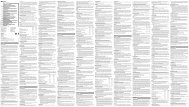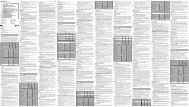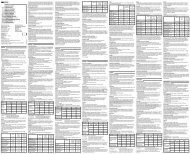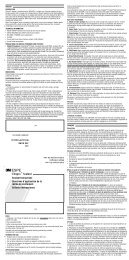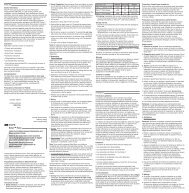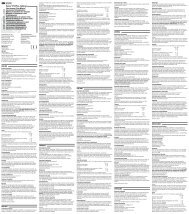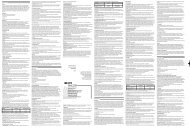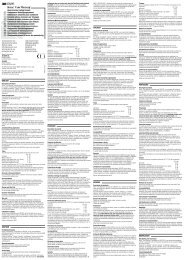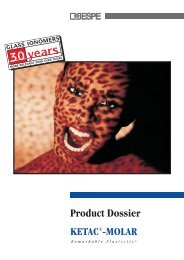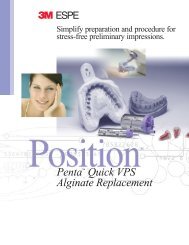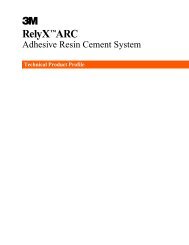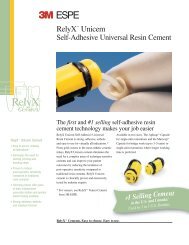RelyX Fiber Post Technical Profile - US - Dental Lab â High Quality ...
RelyX Fiber Post Technical Profile - US - Dental Lab â High Quality ...
RelyX Fiber Post Technical Profile - US - Dental Lab â High Quality ...
Create successful ePaper yourself
Turn your PDF publications into a flip-book with our unique Google optimized e-Paper software.
Glass <strong>Fiber</strong> <strong>Post</strong><br />
<strong>Technical</strong> Product <strong>Profile</strong><br />
<strong>RelyX</strong> <strong>Fiber</strong> <strong>Post</strong><br />
TM
Table of Contents<br />
1. Introduction . . . . . . . . . . . . . . . . . . . . . . . . . . . . . . . . . . . . . . . . . . . . . . . . . . . . . . . . . . . . . . . . . 5<br />
2. Indications . . . . . . . . . . . . . . . . . . . . . . . . . . . . . . . . . . . . . . . . . . . . . . . . . . . . . . . . . . . . . . . . . . 5<br />
3. Clinically Relevant Product Properties . . . . . . . . . . . . . . . . . . . . . . . . . . . . . . . . . . . . . . . . . . . .6<br />
3.1. Material Properties . . . . . . . . . . . . . . . . . . . . . . . . . . . . . . . . . . . . . . . . . . . . . . . . . . . . . . . . . . 6<br />
3.1.1. Sizes . . . . . . . . . . . . . . . . . . . . . . . . . . . . . . . . . . . . . . . . . . . . . . . . . . . . . . . . . . . . . . . . . . . 6<br />
3.1.2. Shape . . . . . . . . . . . . . . . . . . . . . . . . . . . . . . . . . . . . . . . . . . . . . . . . . . . . . . . . . . . . . . . . . . 6<br />
3.1.3. Radiopacity . . . . . . . . . . . . . . . . . . . . . . . . . . . . . . . . . . . . . . . . . . . . . . . . . . . . . . . . . . . . . 6<br />
3.1.4. Composition . . . . . . . . . . . . . . . . . . . . . . . . . . . . . . . . . . . . . . . . . . . . . . . . . . . . . . . . . . . . 7<br />
3.2. The Shift from Metal to <strong>Fiber</strong> <strong>Post</strong>s . . . . . . . . . . . . . . . . . . . . . . . . . . . . . . . . . . . . . . . . . . . .7<br />
3.2.1. Translucency . . . . . . . . . . . . . . . . . . . . . . . . . . . . . . . . . . . . . . . . . . . . . . . . . . . . . . . . . . . . 7<br />
3.2.2. Elasticity . . . . . . . . . . . . . . . . . . . . . . . . . . . . . . . . . . . . . . . . . . . . . . . . . . . . . . . . . . . . . . . 7<br />
3.3. The Long-lasting <strong>Post</strong> . . . . . . . . . . . . . . . . . . . . . . . . . . . . . . . . . . . . . . . . . . . . . . . . . . . . . . . . 8<br />
3.3.1. Fatigue Test . . . . . . . . . . . . . . . . . . . . . . . . . . . . . . . . . . . . . . . . . . . . . . . . . . . . . . . . . . . . . 8<br />
3.3.2. Shear strength test . . . . . . . . . . . . . . . . . . . . . . . . . . . . . . . . . . . . . . . . . . . . . . . . . . . . . . . 9<br />
3.4. The Best Way to Cement it . . . . . . . . . . . . . . . . . . . . . . . . . . . . . . . . . . . . . . . . . . . . . . . . . . 10<br />
3.4.1. The Reliable Bond . . . . . . . . . . . . . . . . . . . . . . . . . . . . . . . . . . . . . . . . . . . . . . . . . . . . . . 11<br />
Adhesion of <strong>RelyX</strong> Unicem Cement to <strong>RelyX</strong> <strong>Fiber</strong> <strong>Post</strong> . . . . . . . . . . . . . . . . . . . . 11<br />
Adhesion of <strong>RelyX</strong> Unicem Cement to the Root Dentin . . . . . . . . . . . . . . . . . . . . . . 12<br />
3.4.2. The Smart Application . . . . . . . . . . . . . . . . . . . . . . . . . . . . . . . . . . . . . . . . . . . . . . . . . . . 13<br />
Virtually Void-free Cement Application . . . . . . . . . . . . . . . . . . . . . . . . . . . . . . . . . . . . . 13<br />
3.5. The Secure Core . . . . . . . . . . . . . . . . . . . . . . . . . . . . . . . . . . . . . . . . . . . . . . . . . . . . . . . . . . . 14<br />
4. <strong>RelyX</strong> <strong>Fiber</strong> <strong>Post</strong> / <strong>RelyX</strong> Unicem Aplicap Cement: Technique Guide . . . . . . . . . . . . . 15<br />
5. Literature . . . . . . . . . . . . . . . . . . . . . . . . . . . . . . . . . . . . . . . . . . . . . . . . . . . . . . . . . . . . . . . . . . 19<br />
3
1. Introduction<br />
Over the past decade fiber reinforced composite (FRC) posts have gained popularity in the<br />
dental market because of their benefits regarding mechanical properties, aesthetics and removability,<br />
offering predictable clinical performance in several ways.<br />
a) The risk of root fractures is significantly reduced with fiber posts. Stiff and hard metal<br />
posts exert a “wedge effect” that can be compared to that of a metal wedge in a piece of<br />
wood. <strong>Fiber</strong> posts avoid this effect because of the dentin-like elastic properties.<br />
b) Aesthetic demands of full-ceramic restorations are met by fiber posts due to their natural<br />
translucency.<br />
c) In case the endodontic treatment has to be redone fiber posts can be easily removed with<br />
drills.<br />
Despite these clear advantages and the paradigm shift from metal to fiber posts that is also<br />
reflected in the scientific community, there is one drawback: fiber posts have to be adhesively<br />
cemented into the root canal which is difficult for multi-step, moisture sensitive adhesive protocols.<br />
Market research has shown that many dentists expect difficulties with the complex<br />
cementation procedure of fiber posts in the root canal and as a consequence do not use them.<br />
<strong>RelyX</strong> <strong>Fiber</strong> <strong>Post</strong> and <strong>RelyX</strong> Unicem Aplicap Self-Adhesive Universal resin cement with<br />
the <strong>RelyX</strong> Unicem Elongation Tip offer the solution:<br />
<strong>RelyX</strong> Unicem cement offers safe and reliable adhesion without any pre-treatment neither of<br />
the root canal dentin (i.e. etching, priming, and bonding) nor the <strong>RelyX</strong> <strong>Fiber</strong> <strong>Post</strong> (e.g. silanating<br />
and roughening). The <strong>RelyX</strong> Unicem Elongation Tip allows the application of <strong>RelyX</strong><br />
Unicem cement into the root canal in one single step. The Elongation Tip locks securely onto<br />
the <strong>RelyX</strong> Unicem Aplicap nozzle via a simple hook mechanism. The system allows an easy,<br />
time-saving, and virtually void-free cementation of <strong>RelyX</strong> <strong>Fiber</strong> <strong>Post</strong>.<br />
Advantages<br />
<strong>RelyX</strong> <strong>Fiber</strong> <strong>Post</strong>s and<br />
drills are available in three<br />
sizes and are color-coded<br />
to ensure an accurate<br />
match and prevent errors.<br />
Size 1<br />
1.3 mm<br />
Diameter<br />
Size 2<br />
1.6 mm<br />
Diameter<br />
• <strong>RelyX</strong> <strong>Fiber</strong> <strong>Post</strong> is a radiopaque, translucent, glass-fiber reinforced composite root post<br />
• <strong>RelyX</strong> <strong>Fiber</strong> <strong>Post</strong> is an esthetic, conservative, and reliable restoration for severely destroyed<br />
teeth<br />
• <strong>RelyX</strong> Unicem Aplicap self-adhesive resin cement used for a safe and reliable bond between<br />
the root post and the root canal dentin without any pretreatment<br />
• <strong>RelyX</strong> Unicem Aplicap Elongation Tips provides an easy, time-saving, and virtually void-free<br />
cementation of root posts with <strong>RelyX</strong> Unicem cement<br />
2. Indications<br />
Size 3<br />
1.9 mm<br />
Diameter<br />
Universal<br />
Drill/<br />
Reamer<br />
In case of insufficient residual tooth structure (
The <strong>RelyX</strong> <strong>Fiber</strong> <strong>Post</strong> system<br />
comes with a universal<br />
pre-drill and <strong>RelyX</strong> Unicem<br />
Aplicap Elongation Tips to<br />
dispense the cement into<br />
the root canal for virtually<br />
void free cement application.<br />
3. Clinically Relevant Product<br />
Properties<br />
3.1. Material Properties<br />
3.1.1. Sizes<br />
<strong>RelyX</strong> <strong>Fiber</strong> <strong>Post</strong>s and drills are available in three sizes and are color-coded to ensure an accurate<br />
match.<br />
<strong>Post</strong> color code Yellow Red Blue<br />
Diameter of apical post end (mm) 0.70 0.80 0.90<br />
Diameter of coronal post end (mm) 1.30 1.60 1.90<br />
Taper 3.44° (6%) 4.58° (8%) 5.72° (10%)<br />
Length 20 mm 20 mm 20 mm<br />
Tab. 1: <strong>RelyX</strong> <strong>Fiber</strong> <strong>Post</strong> color-coding and sizes<br />
<strong>RelyX</strong> Unicem Aplicap Elongation Tips are designed to also fit into root canals prepared for<br />
the smallest size <strong>RelyX</strong> <strong>Fiber</strong> <strong>Post</strong> (yellow).<br />
3.1.2. Shape<br />
<strong>RelyX</strong> <strong>Fiber</strong> <strong>Post</strong>s have a tapered shape, i.e. they are parallel-walled (cylindrical) at the coronal<br />
end and conical at the apical end. This special design is similar to the anatomical form of the<br />
root. Therefore, the root canal preparation can be done in a conservative way, i.e. without<br />
excessive removal of root canal dentin. Additionally, the transmission of forces from the<br />
coronal part into the root area is reduced. The coronal end of the <strong>RelyX</strong> <strong>Fiber</strong> <strong>Post</strong>s offers a<br />
large surface area for the adhesion of the core build up material and has the most material<br />
thickness to withstand mastication forces.<br />
X-ray image of <strong>RelyX</strong> <strong>Fiber</strong><br />
<strong>Post</strong>s. (3M ESPE internal<br />
data)<br />
3.1.3. Radiopacity<br />
<strong>RelyX</strong> <strong>Fiber</strong> <strong>Post</strong>s are radiopaque. The radiopacity of <strong>RelyX</strong> <strong>Fiber</strong> <strong>Post</strong>s size 3 (blue) equals<br />
approx. 200 – 250% Al. In combination with the radiopaque <strong>RelyX</strong> Unicem cement the outline<br />
of the posts is clearly discernible.<br />
250%<br />
200%<br />
150%<br />
100%<br />
6
3.1.4. Composition<br />
<strong>RelyX</strong> <strong>Fiber</strong> <strong>Post</strong>s are made from glass fibers embedded into a composite resin matrix. For<br />
superior mechanical properties the glass fibers are oriented parallel and are distributed equally<br />
over the surface area. Additionally, during the manufacturing process the glass fibers are pretensioned<br />
for enhanced post stability. Therefore, during the clinical application <strong>RelyX</strong> <strong>Fiber</strong><br />
<strong>Post</strong>s have to be cut with a diamond disc. Wire cutters or similar instruments must not be used.<br />
Otherwise, the glass fibers will be ripped from the composite matrix leading to a loss in<br />
mechanical stability. A two-step manufacturing procedure that includes chemical and thermal<br />
curing assures a virtually complete cure of the composite resin matrix.<br />
Fig. 1: Longitudinal cut (left) and cross section of a <strong>RelyX</strong> <strong>Fiber</strong> <strong>Post</strong> (size 3). Scanning electron microscopy<br />
(SEM) image; magnification 60x (longitudinal cut) and 200x (cross-section). The glass fibers are depicted as<br />
white lines in the longitudinal cut and white spots in the cross section. The glass fibers are surrounded by<br />
composite resin matrix with fillers. (3M ESPE internal data)<br />
3.2. The Shift from Metal <strong>Post</strong>s to <strong>Fiber</strong> <strong>Post</strong>s<br />
3.2.1. Translucency<br />
Due to their advantageous combination of mechanical and esthetic properties fiber posts have<br />
gained increased popularity in recent years. Translucency plays an important role for their<br />
remarkable esthetics. <strong>RelyX</strong> <strong>Fiber</strong> <strong>Post</strong>s are translucent to meet the particular needs of highly<br />
esthetic anterior restorations (e.g. full ceramic restorations). During the post cementation the<br />
translucency facilitates light-curing in the root canal.<br />
Light transmission in a<br />
<strong>RelyX</strong> <strong>Fiber</strong> <strong>Post</strong> lit from<br />
coronal end with a<br />
Freelight 2 (3M ESPE)<br />
curing light.<br />
3.2.2. Elasticity<br />
The “wedge effect” of root posts (Lit. 1) can be overcome when the cemented root post and the<br />
surrounding root canal dentin represent a system with uniform mechanical properties. A prerequisite<br />
is that the modules of elasticity (Young’s Modulus) of all system components are<br />
similar to each other. The higher a material’s modulus of elasticity the less flexible it is. The<br />
modulus of elasticity for <strong>RelyX</strong> <strong>Fiber</strong> <strong>Post</strong>s is in the same range as that of dentin while the<br />
modulus of metal and ceramic posts are many times higher (Fig. 2).<br />
Elasticity Modulus of Dentin and <strong>Post</strong> Materials<br />
0 25 50 75 100 125 150 175 200 225<br />
Dentin<br />
<strong>RelyX</strong><br />
<strong>Fiber</strong> <strong>Post</strong>s<br />
Titanium Alloy<br />
<strong>Post</strong>s (95-105)<br />
Zirconia & Stainless Steel<br />
<strong>Post</strong>s (185-210)<br />
Fig. 2: Elasticity Modulus (GPa) of Dentin and post materials (3M ESPE internal data and Lit. 2)<br />
7
Due to this similarity of elastic properties, <strong>RelyX</strong> <strong>Fiber</strong> <strong>Post</strong>s are able to distribute the forces<br />
taken up at the corona evenly and attenuated to the root without causing peak forces – like<br />
metal posts – that may lead to root fractures (Fig. 3). The tapered shape of the <strong>RelyX</strong> <strong>Fiber</strong><br />
<strong>Post</strong>s further contributes to this effect.<br />
Metal <strong>Post</strong>s<br />
<strong>Fiber</strong> reinforced <strong>Post</strong>s<br />
Root Fracture!<br />
No local peak<br />
forces.<br />
No root fracture!<br />
Fig. 3: Root fractures may result from root posts with little flexibility like metal posts (left) that transmit forces<br />
from the coronal end deep into the tooth. In contrast, due to their elastic properties fiber reinforced posts are<br />
able to spread such forces along the post (right).<br />
Schematic depiction of the<br />
fatigue test setup. The root<br />
post is fixed at both ends of<br />
the cylindrical part of the<br />
post. Then a cyclical load is<br />
applied centrally.<br />
3.3. The Long-Lasting <strong>Post</strong><br />
3.3.1. Fatigue Test<br />
Root posts need to withstand repeating mastication load over a long period of time. In order to<br />
test their long term stability root posts are subjected to cyclic loading comparable to mastication<br />
simulation. <strong>RelyX</strong> <strong>Fiber</strong> <strong>Post</strong>s withstand at least 5,000,000 load cycles without breakage.<br />
Some other types of fiber posts break after far less than 2 million cycles.<br />
6000<br />
Mean Number of Resisted Cycles (x1000)<br />
5000<br />
4000<br />
3000<br />
2000<br />
1000<br />
0<br />
*<br />
<strong>RelyX</strong><br />
<strong>Fiber</strong> <strong>Post</strong><br />
Para<br />
<strong>Post</strong> ®<br />
FibreKor<br />
Luscent<br />
Anchors<br />
**<br />
DT Light-<br />
<strong>Post</strong> ®<br />
* <strong>RelyX</strong> <strong>Fiber</strong> <strong>Post</strong> survived<br />
5,000,000 cycles without<br />
breakage. Then the test<br />
was stopped.<br />
** Under the same test<br />
conditions the D.T. Light<br />
<strong>Post</strong> survived 2,000,000<br />
cycles without breakage.<br />
Then the test was stopped.<br />
8<br />
Fig. 4: In the fatigue test <strong>RelyX</strong> <strong>Fiber</strong> <strong>Post</strong>s survive at least 5,000,000 load cycles without breakage.<br />
(Study by Prof. Ferrari, University of Siena, Italy, Lit. 3)
3.3.2. Shear strength test<br />
Next to the preparation technique (“ferrule design”) the shear strength of the root post contributes<br />
to the overall stability of the restoration. The shear strength of <strong>RelyX</strong> <strong>Fiber</strong> <strong>Post</strong>s<br />
equals or exceeds other brands (Fig. 5).<br />
1,8<br />
Schematic depiction of the<br />
shear strength test setup.<br />
The root posts are loaded<br />
at an angle of 135 degrees<br />
until breakage occurs.<br />
Shear Force<br />
135°<br />
1,6<br />
Shear Strength [GPa]<br />
1,4<br />
1,2<br />
1<br />
0,8<br />
0,6<br />
0,4<br />
0,2<br />
Coronal extension of dentin<br />
above the shoulder provides<br />
an effective ferrule.<br />
0<br />
<strong>RelyX</strong><br />
<strong>Fiber</strong> <strong>Post</strong><br />
FRC<br />
<strong>Post</strong>ec®<br />
Plus<br />
ER Dentin<br />
<strong>Post</strong><br />
Fibiocore Radix® FibreKor D.T. Light<br />
<strong>Fiber</strong> <strong>Post</strong><br />
<strong>Post</strong>®<br />
Fig. 5: Shear strength testing of <strong>RelyX</strong> <strong>Fiber</strong> <strong>Post</strong>s and other brands. (3M ESPE internal data)<br />
No Ferrule<br />
Ferrule<br />
Thermocycling tests assess the long-term stability under simulated aging conditions. <strong>RelyX</strong><br />
<strong>Fiber</strong> <strong>Post</strong>s exert high shear strength values even after 10,000 thermocycles (Fig. 6) and thereby<br />
meet a key prerequisite for the longevity of restorations.<br />
1,8<br />
1,6<br />
Shear Strength [GPa]<br />
1,4<br />
1,2<br />
1<br />
0,8<br />
0,6<br />
0,4<br />
0,2<br />
0<br />
0 5000 10000<br />
Number of Thermocycles<br />
Fig. 6: The shear strength of <strong>RelyX</strong> <strong>Fiber</strong> <strong>Post</strong>s stays unaffectedly high even after 10,000 thermocycles<br />
(5°C / 55°C). (3M ESPE internal data)<br />
9
3.4. The Best Way to Cement it<br />
<strong>RelyX</strong> Unicem Cement adheres to <strong>RelyX</strong> <strong>Fiber</strong> <strong>Post</strong>s by 3 ways:<br />
• Mechanical interlocking<br />
• Covalent Bonds<br />
• Hydrogen Bonds<br />
During the manufacturing process <strong>RelyX</strong> <strong>Fiber</strong> <strong>Post</strong>s obtain a microporous surface (Fig. 7).<br />
The resulting indentations serve as micro-retentions when they fill up with cement. The<br />
mechanical interlocking contributes the most to the adhesive strength between the post and<br />
the cement. Apart from this the composite matrices of <strong>RelyX</strong> <strong>Fiber</strong> <strong>Post</strong> and <strong>RelyX</strong> Unicem<br />
cement are chemically compatible. Therefore, covalent, i.e. chemical bonds are established<br />
between <strong>RelyX</strong> Unicem cement and <strong>RelyX</strong> <strong>Fiber</strong> <strong>Post</strong>s. Additional adhesion is provided by<br />
non-covalent hydrogen bonds which develop between the <strong>RelyX</strong> Unicem cement and <strong>RelyX</strong><br />
<strong>Fiber</strong> <strong>Post</strong>s molecules.<br />
Due to these effects high bond strength values are achieved between <strong>RelyX</strong> Unicem cement<br />
and <strong>RelyX</strong> <strong>Fiber</strong> <strong>Post</strong>s without any chemical (e.g. silanating) or mechanical pretreatment (e.g.<br />
roughening) of <strong>RelyX</strong> <strong>Fiber</strong> <strong>Post</strong>s. This differentiates the <strong>RelyX</strong> <strong>Fiber</strong> <strong>Post</strong> / <strong>RelyX</strong> Unicem<br />
cement system from other combinations of fiber reinforced posts and cements.<br />
Composite resin matrix<br />
Glass fiber<br />
Glass fiber<br />
Composite resin matrix<br />
10<br />
Fig. 7: The surface of <strong>RelyX</strong> <strong>Fiber</strong> <strong>Post</strong>s is microporous. The glass fibers<br />
are visible as light gray lines between the composite matrix. (SEM images,<br />
magnification 100x, upper; 500x, lower). (3M ESPE internal data)
3.4.1. The Reliable Bond<br />
Adhesion of <strong>RelyX</strong> Unicem Cement to <strong>RelyX</strong> <strong>Fiber</strong> <strong>Post</strong><br />
<strong>RelyX</strong> Unicem cement exerts consistently high bond strength values to <strong>RelyX</strong> <strong>Fiber</strong> <strong>Post</strong>s without<br />
the need for post pretreatment (Fig. 8) such as etching, silanating (e. g. <strong>RelyX</strong> Ceramic<br />
Primer, 3M ESPE, or Monobond S, Ivoclar Vivadent), or a combination of silicatization<br />
(Rocatec System, 3M ESPE) and silanating. For determining bond strength <strong>RelyX</strong> Unicem<br />
cement was applied to the post surface in a disc shape (d = 6.0 mm, h = 4.0 mm) at the conical<br />
part of the posts. <strong>RelyX</strong> Unicem cement was light-cured for 40 seconds and water stored (24hrs<br />
at 36°C) before bond strength was measured in a pull-off setup.<br />
30<br />
25<br />
Bond Strength [MPa]<br />
20<br />
15<br />
10<br />
5<br />
0<br />
Fig. 8: Tensile bond strength (24hrs) of <strong>RelyX</strong> Unicem Cement to <strong>RelyX</strong> <strong>Fiber</strong> <strong>Post</strong> with and without fiber<br />
post pretreatment. (3M ESPE internal data)<br />
In contrast, for other adhesive cements pretreatment with a bonding agent is needed to reach as<br />
high adhesion values as with <strong>RelyX</strong> Unicem cement (Fig. 9). Here too, adhesion was tested at<br />
the conical part of the posts by applying the cements to the post surface (disc: d = 6.0 mm, h =<br />
4.0 mm). All cements were light-cured (<strong>RelyX</strong> Unicem cement 40 seconds, Multilink Automix<br />
and Variolink II 60 seconds). After water storage (24hrs at 36°C) bond strength was measured<br />
in a pull-off setup.<br />
30,00<br />
25,00<br />
No<br />
Pretreatment<br />
<strong>RelyX</strong><br />
Ceramic<br />
Primer<br />
Rocatec System<br />
& <strong>RelyX</strong><br />
Ceramic Primer<br />
Phosphoric Acid<br />
Etching Gel<br />
with silanating<br />
without silanating<br />
Monobond-S<br />
Bond Strength [MPa]<br />
20,00<br />
15,00<br />
10,00<br />
5,00<br />
0,00<br />
<strong>RelyX</strong> Unicem Multilink® Automix Variolink® II<br />
Fig. 9: Tensile bond strength (24hrs) of <strong>RelyX</strong> Unicem Cement and other adhesive resin cements to <strong>RelyX</strong> <br />
<strong>Fiber</strong> <strong>Post</strong> with and without silanating the fiber post. (3M ESPE internal data)<br />
11
Independent of the curing mode (self- or light-curing) <strong>RelyX</strong> Unicem Cement develops high<br />
bond strength to <strong>RelyX</strong> <strong>Fiber</strong> <strong>Post</strong>s without the need of prior post pretreatment (Fig. 10). Bond<br />
strength values of other adhesive cements are comparably high only if the cement was lightcured<br />
and, for some cements, if the posts were treated with bonding before cementation. Testing<br />
conditions were as described above. Cements were either self-cured (stored for 1hr at 36°C /<br />
>95% r. h.) or light-cured (<strong>RelyX</strong> Unicem cement and Maxcem cement 40 seconds, Multilink<br />
Automix and Variolink II 60 seconds). After curing all samples were stored in water at 36°C.<br />
Again, bond strength was measured in a pull-off setup 24hrs after applying the cements.<br />
30,00<br />
25,00<br />
light-cured<br />
self-cured<br />
Bond Strength [MPa]<br />
20,00<br />
15,00<br />
10,00<br />
5,00<br />
0,00<br />
<strong>RelyX</strong> Unicem<br />
(No Pretreatment)<br />
Multilink®<br />
Automix &<br />
Monobond-S<br />
Fig. 10: Tensile bond strength of <strong>RelyX</strong> Unicem Cement to <strong>RelyX</strong> <strong>Fiber</strong> <strong>Post</strong> (size 3) in comparison to<br />
other resin cements. (3M ESPE internal data)<br />
* The manufacturer<br />
does not<br />
recommend<br />
self-curing<br />
for Variolink II<br />
Adhesion of <strong>RelyX</strong> Unicem Cement to Root Dentin<br />
Since its market introduction in 2002 numerous in vivo and in vitro studies and evaluations of<br />
independent research institutes proved the safe and reliable cementation with <strong>RelyX</strong> Unicem<br />
cement. A microtensile bond strength study to both bovine crown and root dentin from the<br />
University of North Carolina (Lit. 4) showed <strong>RelyX</strong> Unicem cement had higher adhesion<br />
values compared to other brands (Fig. 11). For testing, incisors were ground with 600 grit<br />
silicon carbide, pretreated according to manufacturers’ instructions, and the luting cement was<br />
applied and cured. After water storage (24hrs at 36°C) the bond strength was tested using<br />
1mm x 1mm beams.<br />
25<br />
20<br />
*<br />
Variolink® II &<br />
Monobond-S<br />
Maxcem<br />
(No Pretreatment)<br />
Crown Dentin<br />
Root Dentin<br />
Adhesion [MPa]<br />
15<br />
10<br />
5<br />
12<br />
0<br />
<strong>RelyX</strong> Unicem Panavia F Fuji CEM<br />
Fig. 11: Micro tensile bond strength of <strong>RelyX</strong> Unicem Cement and other resin cements to bovine crown<br />
and root dentin (Lit. 4).
In another study (Lit. 6) with extracted human teeth, the authors find higher pull-off adhesion<br />
values for fiber reinforced posts cemented with self-adhesive <strong>RelyX</strong> Unicem Cement than for<br />
those cemented with a conventional adhesive technique requiring etching and bonding.<br />
3.4.2. The Smart Application<br />
Virtually Void-free Cement Application<br />
The use of a lentulo spiral for cement application is not recommended with <strong>RelyX</strong> Unicem<br />
cement as for many other resin cements because of the possible curing acceleration. Therefore,<br />
up to now the luting cement is typically applied to the post surface extra-orally. Then the post<br />
covered with the cement is seated into the root canal. However, this method may cause voids<br />
trapped in the cement layer which may impact both the bond strength and the proper seal of the<br />
cement layer in a negative way. In order to avoid this effect an Elongation Tip for the <strong>RelyX</strong><br />
Unicem Aplicap was developed which can be attached to the Aplicap nozzle and securely locks<br />
via a snap mechanism (page 17, picture 13). The Elongation Tip allows bottom to top filling of<br />
root canals. Keeping the Elongation Tip immersed in the cement during root canal filling<br />
reduces the chance of trapping air bubbles and creating voids.<br />
This has also been proven in a study conducted at the University of Berlin (Lit. 5). Light and<br />
electron microscopy images (Fig. 12) show a significantly reduced number of voids in the<br />
cement layer around posts when the <strong>RelyX</strong> Unicem Aplicap Elongation Tip technique was used<br />
instead of a conventional technique where the cement is applied to the post before it is seated.<br />
<strong>RelyX</strong> Unicem Aplicap<br />
Elongation Tip<br />
Conventional method:<br />
cement application on<br />
the post<br />
Void free<br />
cement<br />
layer all<br />
around<br />
the post<br />
Voids<br />
in the<br />
cement<br />
layer<br />
Fig. 12: The method of cement application determines the number of voids. Light microscopy and SEM<br />
images (cross section) of a simulated root canal filling in an acrylic glass test device.<br />
Left: A simulated root canal filled with <strong>RelyX</strong> Unicem Cement using the new <strong>RelyX</strong> Unicem Aplicap <br />
Elongation Tip.<br />
Right: Resin cement applied using a common method of putting the cement onto the posts before placement.<br />
Voids, which can compromise bond strength, are clearly visible in the cement layer around the post.<br />
13
3.5. The Secure Core<br />
To achieve a secure bond between the composite core build up material and the <strong>RelyX</strong> <strong>Fiber</strong><br />
<strong>Post</strong> it is recommended to apply the respective bonding system to the post and the surrounding<br />
tooth structure as recommended by the manufacturer. After cementation and cleaning off<br />
excess cement the coronal part of the post is treated with the bonding agent. For 3M ESPE<br />
composite materials (e.g. Filtek Supreme Plus, Filtek Z250, and others) 3M ESPE bonding<br />
agents such as Adper Single Bond Plus, Adper Prompt L-Pop , or Adper Scotchbond <br />
Multi-Purpose are recommended. The adhesion test data (Fig. 13) shows that silanating (e.g.<br />
with <strong>RelyX</strong> Ceramic Primer, 3M ESPE) can be omitted without a negative impact on bond<br />
strength.<br />
25<br />
24hrs water storage<br />
thermocycling<br />
20<br />
Bond Strength [MPa]<br />
15<br />
10<br />
5<br />
0<br />
not determined<br />
No<br />
Pretreatment<br />
<strong>RelyX</strong> Ceramic<br />
Primer<br />
Adper Prompt<br />
L-Pop<br />
Adper<br />
Single Bond Plus<br />
Adper Scotchbond<br />
Multi-Purpose<br />
<strong>RelyX</strong> Ceramic Primer &<br />
Adper Prompt L-Pop<br />
<strong>RelyX</strong> Ceramic Primer &<br />
Adper Single Bond Plus<br />
<strong>RelyX</strong> Ceramic Primer &<br />
Adper Scotchbond<br />
Multi-Purpose<br />
Fig. 13: Influence of different post pretreatment methods on bond strength values for Filtek Z250 universal<br />
composite on <strong>RelyX</strong> <strong>Fiber</strong> <strong>Post</strong>s. Adhesion was tested at the conical part of the posts and measured in a<br />
pull-off setup. Tests were performed after water storage (24hrs at 36°C) only or additional thermocycling<br />
(5,000 cycles 5°C / 55°C). (3M ESPE internal data)<br />
14
Technique Guide<br />
CEMENTING ENDODONTIC POST<br />
<strong>RelyX</strong> <strong>Fiber</strong> <strong>Post</strong><br />
<strong>RelyX</strong> Unicem Self-Adhesive Universal Resin Cement<br />
Indicated for for endodontically treated<br />
teeth with significant loss of tooth<br />
structure to increase stability and<br />
retention of subsequent coronal<br />
restorations<br />
A<br />
• Treated root canal with gutta-percha.<br />
• Select universal drill to remove root filling<br />
(1,000-2,000 rpm).<br />
Leave minimum 4 mm of filling apically.<br />
1<br />
2<br />
• Select post size and matching drill.<br />
Use appropriate drill to widen and shape<br />
the root canal.<br />
3<br />
1 of 4<br />
15
CEMENTING ENDODONTIC POST<br />
<strong>RelyX</strong> <strong>Fiber</strong> <strong>Post</strong><br />
<strong>RelyX</strong> Unicem Self-Adhesive Universal Resin Cement<br />
• Insert post to check the fit in the prepared<br />
canal. Should be able to easily remove<br />
the post.<br />
4<br />
• Shorten post to the required length using<br />
a diamond disk and Suction system.<br />
Note: Do not use scissors, scalpels<br />
or similar tools since they will crush<br />
the post and ruin the structure and<br />
stability.<br />
5<br />
• Disinfect the post with alcohol and dry<br />
it with air free of water and oil.<br />
Note: Primer not needed when<br />
cemented with <strong>RelyX</strong> Unicem cement.<br />
6<br />
7<br />
• Clean or disinfect the root canal with<br />
2.5-5.25% sodium hypochlorite solution<br />
(NaOCl). Rinse immediately with<br />
water and dry with paper points.<br />
Note: Do not use hydrogen peroxide<br />
(H2O2), other disinfectants, and EDTA<br />
solutions because their residues can<br />
impair the adhesion strength and curing<br />
reaction of <strong>RelyX</strong> Unicem cement.<br />
2 of 4<br />
16
CEMENTING ENDODONTIC POST<br />
<strong>RelyX</strong> <strong>Fiber</strong> <strong>Post</strong><br />
<strong>RelyX</strong> Unicem Self-Adhesive Universal Resin Cement<br />
• Insert capsule into Activator.<br />
Press down handle completely and<br />
hold for 2-4 seconds.<br />
8<br />
• Insert activated capsule into mixing<br />
device (triturator/amalgamator).<br />
Mix 10 seconds for 3M EPSE<br />
RotoMix Capsule Mixing Unit.<br />
Mix 15 seconds at highest speed<br />
for other mixing devices.<br />
• Attach the <strong>RelyX</strong> Unicem Aplicap<br />
Elongation Tip to the nozzle.<br />
Listen for an audible “click”.<br />
9<br />
10<br />
Note: Do not use Lentulo spirals to<br />
apply the cement in the root canal as<br />
this will cause the cement to set faster.<br />
11<br />
3 of 4<br />
17
CEMENTING ENDODONTIC POST<br />
<strong>RelyX</strong> <strong>Fiber</strong> <strong>Post</strong><br />
<strong>RelyX</strong> Unicem Self-Adhesive Universal Resin Cement<br />
• Begin apically in the root canal and<br />
dispense <strong>RelyX</strong> Unicem cement. Keep<br />
elongation tip immersed in the cement<br />
initially and during the entire cement<br />
application process to avoid trapped<br />
air in the cement.<br />
12<br />
• Seat the post immediately.<br />
Twist slightly and apply moderate<br />
pressure to hold in position.<br />
13<br />
• Apply moderate pressure while<br />
removing excess with appropriate<br />
instruments or a cotton pellet.<br />
14<br />
• Light cure cement for 40 seconds or<br />
allow to self-cure for 5 minutes from<br />
start of mix.<br />
15<br />
4 of 4<br />
3M ESPE Customer Care 1-800-634-2249<br />
Please refer to instructions for more detailed information 44-0007-4406-8<br />
as well as precautionary and warranty information.<br />
© 2006 3M<br />
18
5. Literature<br />
Lit. 1: Stadtler P., Wimmershoff M., Shookoi H., Wernisch J.: The stress transmission of prefabricated<br />
root canal posts; Schweiz Monatsschr Zahnmed. 1995; 105 (11) 1418-24.<br />
Lit. 2: Callister W.D.: Materials Science And Engineering. An Introduction. 5th Ed., Wiley,<br />
New York, p.793-795<br />
Lit. 3: Study by Prof. Ferrari, University of Siena, Italy, 2006, submitted for publication<br />
Lit. 4: Walter R., Miguez P.A., Pereira P.N.R., University of North Carolina, Chapel Hill, <strong>US</strong>A;<br />
Bond Strengths of Resin Luting Materials to Crown and Root Dentin; IADR 2003, Gothenburg<br />
Sweden, #1463<br />
Lit. 5: Watzke R., Naumann M.: Homogeneity of the Cement-Interface of Adhesive Luting<br />
Materials and Glass <strong>Fiber</strong> <strong>Post</strong>s, 84th IADR 2006, Brisbane, Australia<br />
Lit. 6: Bateman G.J., Chadwick R.G., Saunders W.P.H., Lloyd C.H.: Retention of Quartz-Fibre<br />
Endodontic <strong>Post</strong>s with a Self-Adhesive Dual Cure Resin Cement; Eur J Prosthodont Restor<br />
Dent. 2005 Mar 13(1), 33-7<br />
19
3M ESPE AG · ESPE Platz<br />
82229 Seefeld · Germany<br />
E-Mail: info3mespe@mmm.com<br />
Internet: http://www.3mespe.com<br />
3M ESPE <strong>Dental</strong> Products<br />
3M Center, Building 275-2SE-03<br />
St. Paul, MN 55144-1000, <strong>US</strong>A<br />
3M, ESPE, Adper, Aplicap, Filtek,<br />
L-Pop, Prompt, <strong>RelyX</strong>, Rocatec<br />
and Scotchbond are trademarks<br />
of 3M or 3M ESPE.<br />
D.T. Light <strong>Post</strong>, Fibiocore,<br />
FibreKor, FRC <strong>Post</strong>ec, FujiCem,<br />
Luscent, Maxcem, Mulitilink,<br />
Panavia, Para <strong>Post</strong>, Radix and<br />
Variolink are not trademarks of<br />
3M or 3M ESPE.<br />
70-2009-3816-8 (06.2006)



